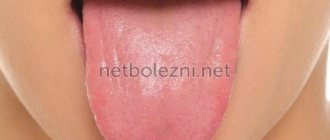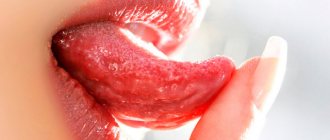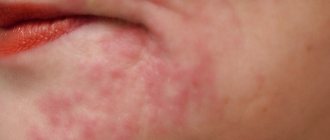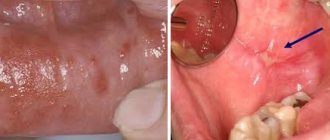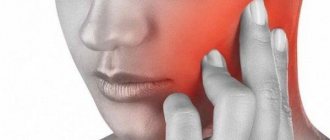Allergic to saxophone?
Did you buy a new lipstick or change your toothpaste? And suddenly my lips were “swept.” What's happened? This is how contact-allergic cheilitis manifests itself. The name itself speaks about the reasons that cause it.
But the culprits of the disease are not only chemicals - sometimes it develops after contact with metal objects. There is even a “professional version” - this type of cheilitis attacks musicians who play wind instruments - the lips react to contact with a metal mouthpiece. Peeling, itching, burning, redness of the lips, and sometimes swelling are unpleasant sensations. The main thing is not to try to get rid of them on your own; you can greatly worsen your condition.
What to do . To find and eliminate the culprit, this most often requires a consultation with an allergist and appropriate examinations to determine the allergen. For treatment, ointments containing corticosteroids, which have antiallergic, antipruritic and anti-inflammatory effects, are used, and antihistamines are also prescribed.
You will also have to watch your diet: give up citrus fruits, strawberries, chocolate, caviar and other foods that can provoke allergic reactions.
Wind and sun are not friends
There is also the so-called meteorological cheilitis, which often develops in those who spend a lot of time in the wind and are often exposed to sudden temperature changes in the air.
And in the southern regions, where the sun shines brightly almost all year round and therefore increases solar radiation, actinic cheilitis is common.
What to do. Lips should be well protected and constantly use hygienic and sun-protective lipstick. And for those who work in the wind, on the street, a special ointment based on lamb fat is suitable, which is no less effective than lipstick.
These two types of cheilitis must be treated promptly and carefully so that they do not gradually become chronic, because against their background, oncological diseases of the lips and oral cavity often rapidly develop.
The most common lip problems are dryness, flaking and cracking. The reason for this is the structural features of the lips. As is known, they are divided into three parts: cutaneous, intermediate and mucous.
- the skin part has a structure similar to that of ordinary skin. It is covered with the epidermis, which is a stratified squamous keratinizing epithelium, and contains appendages - sebaceous, sweat glands and hair follicles with hair;
- the intermediate part - the red border of the lips, in everyday perception is called the lips, is also covered with a stratum corneum, which, however, is very quickly renewed and relatively “immature” cells rise to the surface. In addition, the red border of the lips does not contain skin appendages, but contains a large number of blood vessels and nerve endings;
- The mucous part occupies the posterior surface of the lips and is covered with stratified squamous non-keratinizing epithelium. Moistened with the secretion of the labial salivary glands.
It is precisely because of the rapid renewal of the stratum corneum, as well as the absence of sebaceous and sweat glands, that the skin of the red border of the lips has poor protective barriers, and therefore easily loses water and is sensitive to changes in environmental conditions.
The secretion of the sebaceous and sweat glands of the skin forms a hydrolipid mantle, which is the first line of defense of the skin, causing a pH gradient, which is necessary, among other things, for the normal functioning of enzymes in the stratum corneum and maintaining the functioning of a healthy microbiome, as well as a surface lipid barrier.
As for the rapid renewal of the stratum corneum of the red skin of the lips, such intensity of division does not allow the structures of the epidermis to “mature” normally. As a result, the horny scales and lipid layers of the stratum corneum do not form a sufficiently dense barrier; it remains more permeable than the barrier of normal skin. As a result, this causes accelerated water loss and dry skin. In addition, the latter provokes another problem - it is believed that trypsin- and chymotrypsin-like enzymes play a role in the degradation of desmosomes, the elements that ensure the adhesion of epidermal cells, and the water content in the stratum corneum is mentioned as a factor regulating the activity of these enzymes. Accordingly, with its deficiency, the enzymes do not work effectively enough and complete destruction of desmosomes does not occur - as a result, we observe peeling of the lips. It intensifies under the influence of various external factors - cold, wind, ultraviolet radiation, sharp temperature contrasts, dry air of rooms heated in winter, etc., since if the barrier functions of the skin are insufficient under these conditions, an even greater loss of water occurs and desquamation processes are further disrupted. In addition, against the background of dryness, cracks appear, which cause significant discomfort - as mentioned above, the skin of the lips is very actively innervated. In connection with the above, the main lip care products are considered to be balms containing occlusive components, i.e. those that prevent the evaporation of water from the skin.
Science-Based Lip Care
As you know, there are two fundamentally different ways to moisturize the stratum corneum. The first is to use a non-aqueous ointment based on petroleum jelly or silicone, which creates an occlusive layer on the skin to inhibit the evaporation of water: water accumulates in the stratum corneum and its level of hydration increases.
The second way is to bring water from outside with the help of preparations containing it. These can be gels (water + colloid) or emulsions (water + oil), which contain components that bind water (wetting agents). Moisturizing agents with low molecular weight (such as natural moisturizing factor components and ions) penetrate into the stratum corneum itself, accumulate there and attract water. High-molecular compounds (proteins, polysaccharides, glycols) remain on the surface of the skin and form a kind of wet compress.
The main ingredient in lip care products is most often Vaseline, which is considered one of the most powerful occlusive agents. However, it only retains moisture without restoring the natural barrier properties of the lips, on the contrary - due to the fact that Vaseline moisturizes too well, it can slow down the restoration of the epidermal barrier, the cells will not receive a signal in time that the barrier needs repair.
It is generally accepted that if barrier function cannot be restored (for example, in atopic dermatitis due to genetic defects), occlusive agents are necessary for permanent use. However, when you stop using them, everything usually returns to normal, some people even develop a kind of “dependence” on lip balms - if they apply them, relief comes, but as soon as they stop using these products, complaints about dryness and flaking return again. Therefore, if there is still a chance to restore barrier structures, occlusive agents should be used only at the initial stage.
And in the case of the barrier function of the lips, there is such a chance. And this is another way to increase skin hydration and restore its natural protective barrier. Recent studies have shown that in the lipid layers of the stratum corneum of the skin, the balance of ceramides is disturbed - one of the main (and most significant in quantity) components of the lipid barrier, along with cholesterol and free fatty acids (all these lipids are classified as so-called physiological lipids). Intercellular lipids of the stratum corneum hold the scales together (“cement”) and form the basis of the permeability barrier (lipid barrier), which prevents the diffusion of substances through the stratum corneum in both directions. A change in the ratio of lipids in the composition of the lipid barrier leads to disruption of its function.
It has been shown that in the stratum corneum of the red border of the lips, the amount of ceramides as such is generally reduced, while their imbalance is also observed - a higher percentage of such ceramide subtypes as CER [NS] (with short-chain CER [NS] dominating) and CER [AS ] and a lower percentage of CER [NP] and CER [NH] compared to other areas of the body skin.
In a recent study, Japanese scientists examined whether ceramides could reduce lip dryness and flaking as well as highly occlusive formulations. They used synthetic pseudoceramide (pCer, Cetyl PG hydroxyethyl palmitamide), which has already proven itself in the treatment of atopic dermatitis. Moreover, this pseudoceramide was included in the composition of the product that does not provide occlusion.
The study involved 31 healthy women (age range from 21 to 37 years; average age 28.6 years) with normal skin and complaints of dry lips. All women were divided into three groups according to the products used: control (a product without ceramides, which has moderate occlusive properties and confirmed its effect in one of the scientists' previous trials), a non-occlusive product with 0.5% pCer and with 2.0% pCer. Each sample was applied four times a day (morning, noon, evening, before bed) for 4 weeks. The degree of lip roughness, lip hydration, rate of transepidermal water loss (TEWL) and elasticity of the lip surface were assessed. Endogenous ceramide profiles and pCer absorption levels in the stratum corneum were also determined.
As a result, after 4 weeks in the group of women who used the drug 2.0% pCer, there was a significant decrease in roughness compared to the initial level, as well as with the drug with lower concentrations of ceramide and the control occlusive agent. Moreover, the improvement increased by the 4th week, at a time when by this time the effect of 0.5% of the drug had only appeared. Also, by week 4, the 2.0% pCer group showed a decrease in TEWL and an increase in lip hydration and elasticity. Interestingly, hydration and TEWL rates also improved in the control occlusive group by the second week, but then gradually decreased. A decrease in the amount of CER [NS] was also noted, an increased concentration of which is found not only on the lips, but also in atopic dermatitis, i.e. it is a marker of skin barrier failure. The amount of CER [NH], the low content of which has a high correlation with lip roughness, and CER [NP] also increased.
Regarding the absorption of pCer, it is quite natural that the higher its content, the better the absorption. However, since the amount of pCer absorbed at 2 weeks was much greater than at 4 weeks, this was also associated with increased lip roughness at first. By improving this parameter, absorption may stabilize.
What conclusions can be drawn from this information? For lip care, it is effective to use not just occlusive preparations that retain water, but to strengthen the natural barrier function of the lip skin with the help of physiological lipids - primarily in the form of ceramides. And the better the restoration of the lipid barrier, the less “dependence” you will have on classic Vaseline-based lip balms.
Sources:
Arai S., Oshida, K., Hikima, T. and Fukuda, Y. Study on lip surface-characteristics of stratum corneum and corneocytes on lip. J. Jap. Cosmet. Sci. Soc. 14, 66–70 (1990).
Arai, S., Oshida, K., Hikima, T. and Hasunuma, K. Study on lip surface-characteristics of chapped lip. J. Jap. Cosmet. Sci. Soc. 13, 64–68 (1989).
Hikima, R., Igarashi, S., Ikeda, N. et al. Development of lip treatment on the basis of desquamation mechanism. IFSCC Mag. 7, 3–10 (2004).
Ishikawa J., Shimotoyodome, Y., Ito, S., Miyauchi, Y., Fujimura, T., Kitahara, T., Hase, T. Variations in the ceramide profile in different seasons and regions of the body contribute to the stratum corneum functions. Arch. Dermatol. Res. 305, 151-162 (2013).
Shimotoyodome Y., Tsujimura, H., Ishikawa, J., Fujimura, T., Kitahara, T. Variations of ceramide profile in different regions of the body of Japanese females. J. Jap. Cosmet. Sci. Soc. 38(1), 3-8 (2014).
Imokawa G. A possible mechanism underlying the ceramide deficiency in atopic dermatitis: expression of a deacylase enzyme that cleaves the N-acyl linkage of sphingomyelin and glucosylceramide. J. Dermatol. Sci. 55, 1–9 (2009).
Tamura E., Yasumori H., Yamamoto T. The efficacy of a highly occlusive formulation for dry lips. Int J Cosmet Sci. 2020 Feb;42(1):46-52.
Tamura E., Ishikawa J., Yasuda Y., Yamamoto T. The efficacy of synthetic pseudo-ceramide for dry and rough lips. Int J Cosmet Sci. 2020 Nov 30.
Another crack?
A serious problem is a crack in the middle of the lip, which is very difficult to get rid of - the inflammatory process is “stimulated” by microbes that get into it, which prevents healing, and the lip in this place often bursts again and again. And this is not only a cosmetic flaw that spoils life - the crack causes pain when talking and eating. The disease can be triggered by injuries, lack of vitamins, smoking and meteorological factors.
What to do . First of all, find the reason that causes the crack to form again and again. And be patient to complete the course of treatment. The doctor will prescribe drugs that have an anti-inflammatory effect and accelerate the formation of epithelium at the site of injury. Sometimes antibiotics are needed.
In extremely difficult cases, they resort to excision of the crack. When the course of treatment is completed, it is important to ensure protection against relapse: use hygienic lipstick, forget about childhood habits: do not lick your lips, do not suck a pencil, do not bite your nails, give up spicy and too hot food.
Preventive measures
To avoid the formation of a whitish coating and characteristic clots on the lips, it is advisable to adhere to the following expert recommendations:
- timely treatment of gums and teeth,
- maintain proper oral care,
- create the right diet - reduce the amount of simple carbohydrates and sugar,
- maintain a drinking regime,
- reduce the consumption of alcohol and tobacco products to a minimum,
- strengthen the immune system, take vitamins A, B, E,
- use a hygienic balm that prevents the appearance of cracks on your lips.
It is important to observe the rules of personal hygiene to prevent the appearance of films in infants. You must remember to boil bottles, pacifiers and periodically wash all toys with soap.
As doctors note, plaque can signal the presence of various health problems, but before starting treatment, it is worth finding out why it formed. Only an accurate diagnosis of the disease will help speed up the recovery process and prevent complications.
Continuous geography
Often, during an examination, the doctor asks: “Show your tongue!”: by its appearance, one can suspect symptoms of a variety of diseases. But the tongue also has its own specific diseases. One of them is desquamative glossitis, in which the surface layer of the mucous membrane begins to peel off, or, as experts say, slough off. As a result, in some areas of the tongue there are no filiform papillae left at all, and they acquire a bright red color, while a light coating appears on the neighboring ones.
If hair grows in your mouth
Of course, this does not happen, but sometimes it seems that the tongue is covered with... hair. The fact is that thread-like papillae grow on the tongue, and their length can reach one and a half centimeters, and they become like hairs. This phenomenon is observed in cases of impaired immunity, in response to certain medications that disrupt the microflora of the oral cavity, as well as in patients with chronic gastritis and colitis. There is nothing wrong with this, but the patient experiences unpleasant sensations that create constant discomfort.
What to do . If possible, you should stop taking medications and take only antihistamines. After 5–10 days, the “hair” on the tongue will disappear. And don’t forget to brush not only your teeth, but also your tongue twice a day.
How much does lip augmentation cost: price 2021
For lip augmentation procedures, the price will depend on the brand of filler used, as well as its volume. To increase the volume of the lips of still quite young patients, 0.5 to 1.0 ml of the drug is usually sufficient. With pronounced age-related atrophy of lip tissue, as a rule, a larger amount of material is needed - about 1.5-2.0 ml. The required volume of material will also depend on the type of filler. For example, fillers that are not fully hydrated with water will expand in the tissues within a day after the procedure, so they are required in a smaller volume than fully hydrated fillers.
Prices may vary significantly if you have the procedure done at a dermatological center or with a private cosmetologist. For example, the price in the clinic for 1.0 ml of Juvederm Ultra 3 is usually about 13,500 rubles. However, in beauty salons the price can be 10,000 rubles (for the same volume of the drug). In some cases, it must be admitted, private cosmetologists use “gray import” drugs. This will be evidenced by the fact that a cosmetologist offers you a price for a service that is close to the cost of the drug itself.
Price for 1.0 ml in specialized clinics in Moscow and St. Petersburg –
- Juvederm Ultra 3 – about 13,000 rubles.
- Juvederm Volbella - about 15,000 rubles.
- Restylane Lip Volume – from RUB 16,000.
- Juvederm Ultra Smile - about 16,000 rubles (for 1.1 ml), and from 8,000 rubles - for 0.55 ml.
Be careful, border!
Oncological diseases of the lips and oral cavity usually creep up unnoticed; all of them can now be successfully treated if you consult a doctor in time. What symptoms should you pay attention to?
Sometimes a malignant formation can cause a harmless-looking spot on the lip. Although it often does not bother you for several months, then an erosion or ulcer suddenly forms, which seems to sink inside the lip and harden.
In men after forty years of age, a wart often appears on the lip, which quickly becomes covered with papillae, becomes horny and lasts for 4–6 months. It is best to remove it as soon as possible.
In general, if you feel any discomfort in your mouth or notice something “suspicious,” do not put off visiting the dentist. Be attentive to yourself!
What does white plaque indicate - diagnostics
What does the formation of a whitish film mean? You can conduct preliminary diagnostics and identify the suspected cause of the problem by its location and main characteristics:
- cheilitis, herpes - clots form on the outside of the lips,
- candidiasis - accumulation on the inside of the lips in the form of a cheesy layer,
- problems of the gastrointestinal tract - clots look like a sticky film,
- vitamin deficiency, alcohol and nicotine addiction - a whitish coating collects in the corners of the mouth.
Accumulations under the lip also occur with fungal infections of the mucous membrane. If they cover the palate, tonsils, the inside of the cheeks and the tongue, then this is a severe form of infection. In men, this type of formation is most often the result of smoking.
